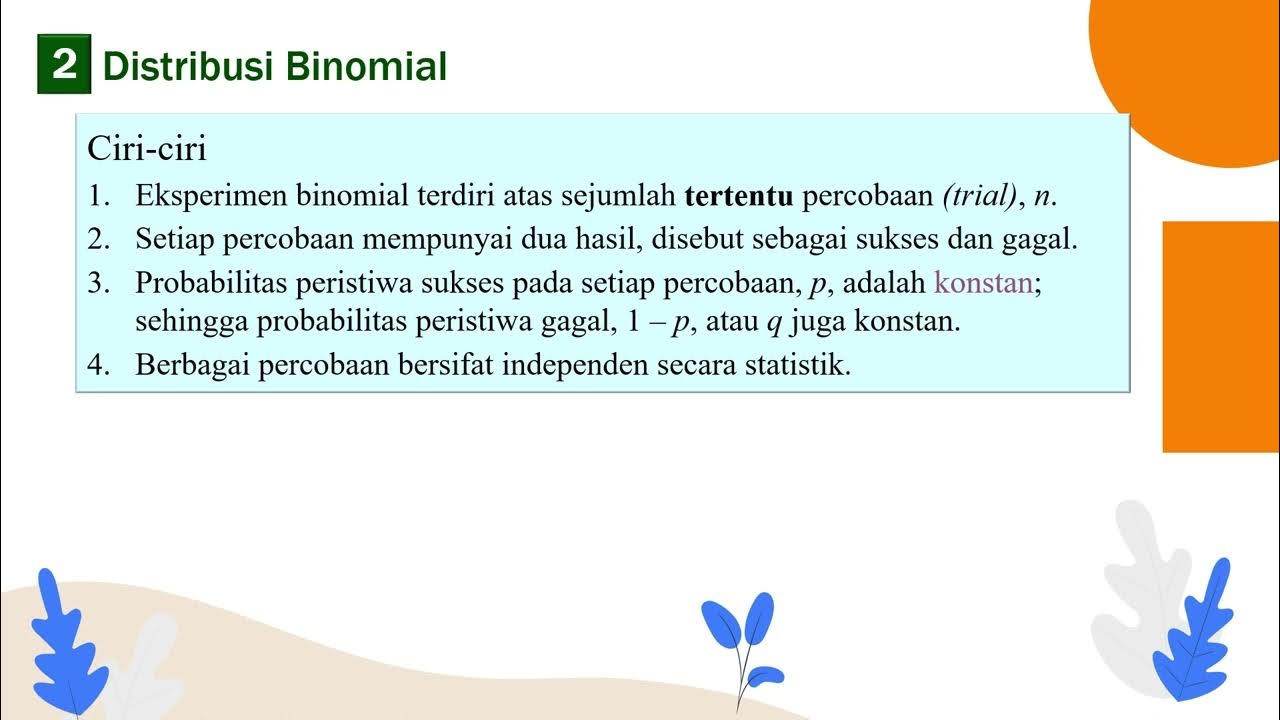Repeated independent trial and Bernoulli distribution
Summary
TLDRThe video discusses fundamental concepts in probability, particularly focusing on the binomial distribution through a practical example of disease incidence testing. It highlights the significance of random selection in determining the probability of testing positive for a disease and examines the framework of independent Bernoulli trials. By modeling the outcomes of repeated tests, the speaker introduces the binomial distribution, setting the stage for a deeper understanding of how probabilities can be calculated and applied in real-world situations. This engaging exploration of statistical principles aims to enhance comprehension of probability in practical contexts.
Takeaways
- 😀 Probability calculations are central to understanding success in independent trials.
- 😀 The concept of independence and disjoint events is crucial for accurate probability assessment.
- 😀 To find the overall probability, sum the probabilities of independent events.
- 😀 The incidence of a disease can be modeled by selecting individuals randomly from a population.
- 😀 The probability of testing positive for a disease can be assumed to be the same as the fraction of the population with the disease.
- 😀 This assumption holds well when individuals are selected randomly across different locations.
- 😀 Repeating trials n times allows us to observe outcomes more reliably.
- 😀 Each trial in a series of independent tests is categorized as a Bernoulli trial.
- 😀 The outcome we are interested in is the number of positive test results in these trials.
- 😀 The binomial distribution is used to model the number of successes in n independent Bernoulli trials.
Q & A
What is the main focus of the lecture discussed in the script?
-The lecture primarily focuses on understanding probability, particularly in the context of disease incidence and testing.
How does the speaker describe the calculation of probabilities?
-The speaker describes the calculation of probabilities as relying on the principles of independence and disjoint events, allowing for summation to find overall probabilities.
What example does the speaker use to illustrate the concept of probability?
-The speaker uses an example involving a disease's incidence in a city, discussing the probability of selecting an individual who tests positive for that disease.
Under what condition is it reasonable to assume that the probability of testing positive is equal to the fraction of people with the disease?
-It is reasonable to assume this equality when individuals are selected randomly from various locations, avoiding any clustering that might bias the results.
What is meant by independent Bernoulli trials in this context?
-Independent Bernoulli trials refer to a series of tests where each trial has two possible outcomes (such as positive or negative for a disease), and the outcome of each trial does not influence the others.
What outcome does the speaker aim to determine through repeated testing?
-The speaker aims to determine the number of positive test results (successes) in relation to the total number of trials conducted (n) and the probability of success (p).
What statistical distribution is introduced at the end of the transcript?
-The binomial distribution is introduced, which models the number of successes in a fixed number of independent Bernoulli trials with a constant probability of success.
Why is the concept of binomial distribution important in the context of disease incidence?
-The binomial distribution is important because it provides a framework for predicting the likelihood of a certain number of positive test results, helping in understanding disease spread and testing effectiveness.
What assumptions must be considered when using the binomial distribution in health-related scenarios?
-Assumptions include the independence of trials, a fixed number of trials, and a constant probability of success across those trials.
How does the speaker suggest evaluating the success of the testing process?
-The speaker suggests evaluating the success by analyzing the number of positive test results obtained from the trials, which can help gauge the incidence of the disease in the population.
Outlines

This section is available to paid users only. Please upgrade to access this part.
Upgrade NowMindmap

This section is available to paid users only. Please upgrade to access this part.
Upgrade NowKeywords

This section is available to paid users only. Please upgrade to access this part.
Upgrade NowHighlights

This section is available to paid users only. Please upgrade to access this part.
Upgrade NowTranscripts

This section is available to paid users only. Please upgrade to access this part.
Upgrade NowBrowse More Related Video

Sesi 5 3 Distribusi Probabilitas Bagian 3

Distribusi Binomial • Part 6: Contoh Soal Distribusi Peluang Variabel Acak Diskrit (3)

Distribusi Binomial • Part 9: Distribusi Peluang Binomial

Metode Statistika | Sebaran Peluang Diskrit | Bernoulli | Binomial | Poisson

Kelas XII / Distribusi Peluang Binomial

Pembahasan Contoh Soal Distribusi Binomial - Penjelasan Singkat dan Jelas
5.0 / 5 (0 votes)